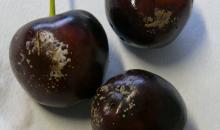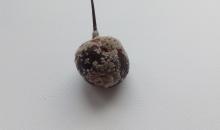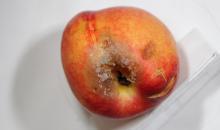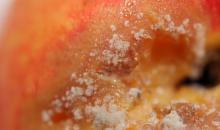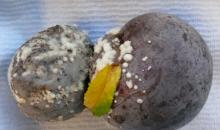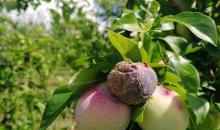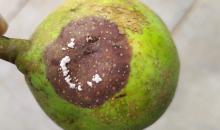Monilinia fructicola(MONIFC)
Photos
For publication in journals, books or magazines, permission should be obtained from the original photographers with a copy to EPPO.

Lesions on apricot fruit due to M. fructicola, M. laxa & M. fructigena.Top left-control; top centre-M. laxa; top right-M. fructigena;bottom left-M. fructigena; bottom centre-M. fructicola; bottom right-M.laxa.
Courtesy: University of New South Wales (AU).
Lesions on pear fruit due to M. fructicola, M. laxa & M. fructigena. Top left-control; top centre-M. laxa; top right-M. fructigena; bottom left-M. fructigena; bottom centre-M. fructicola; bottom right-M.laxa.
Courtesy: H.J. Willetts, University of New South Wales (AU).
Cultural characteristics of Monilinia fructicola on PDA (2a) and V8 (2c) media in the dark at 25°C, compared with M. laxa (2b and d, respectively) -
Courtesy: University of New South Wales (AU).
Colonies of M. fructigena (top left), M. laxa (top right), M. fructicola (bottom).
Courtesy: H.J. Willetts - University of New South Wales (AU).
Top row: PDA cultures of M. fructicola have concentric rings. Middle row: PDA cultures of M. laxa produce lobed rosettes. Bottom row: PDA colonies of M. fructigena do not produce rosettes and are creamy yellow rather than greyish.
Courtesy: GCM. van Leeuwen,Wageningen (NL)
Lesions on plum fruit due to M. fructicola, M. laxa & M. fructigena.Top left-control; top centre-M. laxa; top right-M. fructigena;bottom left-M. fructigena; bottom centre-M. fructicola; bottom right-M.laxa.
Courtesy: University of New South Wales (AU).


